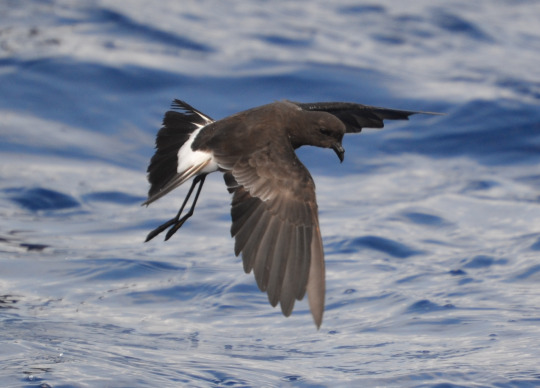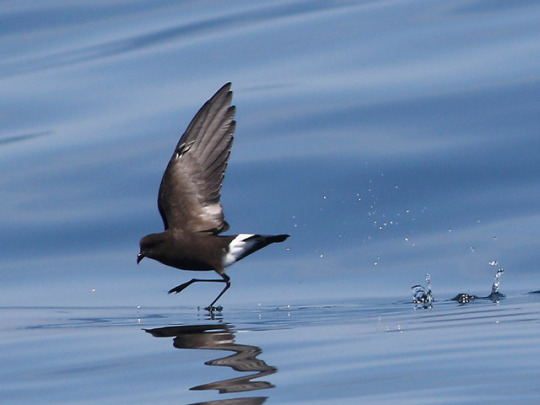#Oceanites oceanicus
Explore tagged Tumblr posts
Text


Photo source
Map source
#poll#birds#wilson's storm petrel#procellariiformes#oceanitidae#oceanites#oceanites oceanicus#america#north america#south america#asia#erope#eurasia#africa#oceania#australia#antarctica
9 notes
·
View notes
Text
BOTD: Wilson's Storm-Petrel

Photo: Joseph D Kurtz
"Despite its small size and seemingly weak flight, this bird is at home on the roughest of seas, flying in the troughs of the waves during gales. It also travels huge distances -- from the Antarctic to the edge of the Arctic. Although it nests only in far southern oceans, Wilson's Storm-Petrel is often the most common seabird off the Atlantic Coast of the United States."
- Audubon Field Guide
#birds#wilson's storm petrel#birds of north america#north american birds#seabirds#petrels#storm petrels#wilsons storm petrel#birds of the us#birds of canada#birds of the caribbean#birds of america#american birds#birding#bird#birdblr#birblr#bird watching#bird of the day#Oceanites oceanicus
19 notes
·
View notes
Photo

Wilson's Storm-Petrel (Oceanites oceanicus)
© David Wingate
7 notes
·
View notes
Photo

Oceanites oceanicus by gkjarvis
#bird#birds#animal#animals#nature#biology#wildlife#Procellariiformes#Oceanitidae#Oceanites#Oceanites oceanicus
2 notes
·
View notes
Photo

Wilson’s Storm Petrel (Oceanites oceanicus)
Fifty miles out to sea, on almost every ocean of the world, tiny, sooty birds dart over the waves, catching on breezes, and pattering little yellow-webbed feet on the water surface.
Not much bigger than a swallow, the Wilson’s Storm Petrel (Oceanites oceanicus) appears to walk on water. It uses its brightly patterned feet to stir up and attract plankton to the surface as it glides over the ocean.
Wilson’s Storm Petrels are one of the most abundant bird species in the world, but they only come to land briefly, and only after dark. They breed on islands near Antarctica in burrows or rock crevices, where larger predatory birds like gulls and skuas would happily snack on them.
By visiting their chicks only at night, the small Storm Petrels avoid unwanted, and deadly, attention. photograph by Ed Dunens on Flickr CC
via: Peterson Field Guides
30 notes
·
View notes
Photo

PAINHO DE WILSON/ WILSON’S STORM-PETREL/ Oceanites oceanicus
About 11 miles off Portimão (Faro, Portugal), 12-Set-2010
Câmara Nikon Coolpix P5100/ Nikon Coolpix P5100 camera
Luís Gordinho
0 notes
Video
instagram
. . طائر طائر نوء ويلسون - Whooping crane . . التصنيف العلمي المملكة : الحيوانية الفئة : إيفس الترتيب : نوئيات الأسرة : Oceanitidae جنس : Oceanites الأنواع : O. oceanicus الاسم العلمي : Oceanites oceanicus . . تواجدها على السواحل في القطب الجنوبي والجزر القريبة مثل جزر شيتلاند الجنوبية و يقضي بقية العام في البحر وينتقل إلى المحيطا�� الشمالية في فصل الشتاء في نصف الكرة الجنوبي . It is located on the coasts of the Antarctic and nearby islands such as the South Shitland Islands and spends the rest of the year in the sea and moves to the northern oceans in winter in the southern hemisphere . . . ❤لا اله الا الله محمد رسول الله صلى الله عليه وسلم There is no god but Allah and Muhammad is the messenger of God❤ . . . . 🍁 عن الأعرج عن أبي هريرة أن رسول الله صلى الله عليه وسلم قال إذا نودي للصلاة أدبر الشيطان وله ضراط حتى لا يسمع التأذين فإذا قضى النداء أقبل حتى إذا ثوب بالصلاة أدبر حتى إذا قضى التثويب أقبل حتى يخطر بين المرء ونفسه يقول اذكر كذا اذكر كذا لما لم يكن يذكر حتى يظل الرجل لا يدري كم صلى 🍁 . 🌺🌹 رواه البخاري - 583 🌺🌹 . . . . 📌 باب بدء الأذان وقوله عز وجل ((( وَإِذَا نَادَيْتُمْ إِلَى الصَّلَاةِ اتَّخَذُوهَا هُزُوًا وَلَعِبًا ۚذَٰلِكَ بِأَنَّهُمْ قَو��مٌ لَّا يَعْقِلُونَ (58) ))) سورة المائدة . وقوله (((إِذَا نُودِيَ لِلصَّلَاةِ مِن يَوْمِ الْجُمُعَةِ ))) سورة الجمعة 📌 . 🍁 حدثنا عمران بن ميسرة حدثنا عبد الوارث حدثنا خالد الحذاء عن أبي قلابة عن أنس بن مالك قال ( ذكروا النار والناقوس فذكروا اليهود والنصارى فأمر بلال أن يشفع الأذان وأن يوتر الإقامة ) 🍁 . 🌺🌹 رواه البخاري - 578 🌺🌹 . . . . قران - Quran . . . @bosaif_aldhaheri @bosaif_aldhaheri @bosaif_aldhaheri . . (((أَشْهَدُ أَنْ لاَ إِلَهَ إِلاَّ اللَّهُ.أَشْهَدُ أَنَّ مُحَمَّدًا رَسُولُ))) (((I bear witness that there is no God but Allah and that Muhammad is His servant/slave and His messenger))) .
0 notes
Photo

Wilson's Storm Petrel Oceanites oceanicus is a species of seabird best known for its ability to "walk on water". These small birds will hover just above the water’s surface in order to pluck at plankton underneath. Their feet will dip in at a spot in the water (perhaps to attract prey), and the bird will nab the food and then flutter to a new spot a little ways away. The “Storm” in the bird’s name refers to the idea that the appearance of flocks of the bird foretold of a coming storm. Wilson's Storm Petrels are some of the most numerous of seabirds, and have an extremely wide range, visiting all major oceans except the Arctic. Wilson’s storm-petrel breeds around the cold waters of Antarctica, on rocky islets, cliffs and amongst boulder scree. During the southern winter it heads north, and may be seen around small rocky islands in the Atlantic and Indian Oceans. These seabirds are listed as a species of Least Concern by the IUCN Red List. Learn more about the incredible marine life in our world's oceans by visiting us at: www.theterramarproject.org Photo: JJ Harrison/Wikimedia Commons (CC BY-SA 3.0)
0 notes
Photo

December 24, 2014 - Wilson’s Storm-Petrel (Oceanites oceanicus)
Spending most of their time at sea, these storm-petrels are found around the world in all but the Arctic Ocean. They eat crustaceans, small fish, and other small marine animals, sometimes following ships to scavenge for scraps. Hovering with their feet touching the surface, they pluck food from the water. Starting in November, they nest in crevices on cliffs and islands around Antarctica and the southern tip of South America. The males arrive at nesting sites first and began calling to attract females. Both parents incubate and care for the chicks.
21 notes
·
View notes
Photo


FRIENDSHIP (feeding association) BETWEEN STORM PETRELS AND ROUGH-TOOTED DOLPHINS
Several seabird species are known to associate with foraging cetaceans to take opportunity of live prey disturbed and pushed closer to the surface or remains that can be scavenged . Such associations may provide important food resources for seabirds, some species showing strong association to cetaceans (as Procellaria, petrels and albatroses)
A pod of Rough-toothed Dolphins (Steno bredanensis) was observed catching (on 2012) and tearing apart several Castin Leatherjacks near Montão de Trigo Island, northern coast of São Paulo, Brazil. The resulting floating masses of viscera attracted a feeding aggregation of 120-150 Wilson's Storm-petrels (Oceanites oceanicus), a transequatorial migrant passing through the area during October. This interspecific association has not been recorded before, although it could be expected given that S. bredanensis feeds on large fish and O. oceanicus is a known scavenger of kills made by cetaceans such as Orca Whales.
Reference (Open Access) Olmos et al, 2013. A feeding association between Wilson's Storm-petrels Oceanites oceanicus (Kuhl, 1820) and Rough-toothed Dolphins Steno bredanensis (G. Cuvier in Lesson, 1828). Biota Neotropica
#Oceanites oceanicus#Wilson's Storm-petrels#procelariiformes#aves#delphinidae#Steno bredanensis#animals#behavior#kleptoparasitism#science#marine biology#brazil
4 notes
·
View notes
Photo

PAINHO DE WILSON/ WILSON’S STORM-PETREL/ Oceanites oceanicus
About 11 miles off Portimão (Faro, Portugal), 12-Set-2010
Câmara Nikon Coolpix P5100/ Nikon Coolpix P5100 camera
Luís Gordinho
0 notes
Photo

PAINHO DE WILSON/ WILSON’S STORM-PETREL/ Oceanites oceanicus
About 11 miles off Portimão (Faro, Portugal), 12-Set-2010
Câmara Nikon Coolpix P5100/ Nikon Coolpix P5100 camera
Luís Gordinho
0 notes
Photo

PAINHO DE WILSON/ WILSON’S STORM-PETREL/ Oceanites oceanicus
About 11 miles off Portimão (Faro, Portugal), 12-Set-2010
Câmara Nikon Coolpix P5100/ Nikon Coolpix P5100 camera
Luís Gordinho
0 notes
Photo

PAINHO DE WILSON/ WILSON’S STORM-PETREL/ Oceanites oceanicus
About 11 miles off Portimão (Faro, Portugal), 12-Set-2010
Câmara Nikon Coolpix P5100/ Nikon Coolpix P5100 camera
Luís Gordinho
0 notes
Photo

PAINHO DE WILSON/ WILSON’S STORM-PETREL/ Oceanites oceanicus
About 11 miles off Portimão (Faro, Portugal), 12-Set-2010
Câmara Nikon Coolpix P5100/ Nikon Coolpix P5100 camera
Luís Gordinho
0 notes
Photo

PAINHO DE WILSON/ WILSON’S STORM-PETREL/ Oceanites oceanicus
About 11 miles off Portimão (Faro, Portugal), 12-Set-2010
Câmara Nikon Coolpix P5100/ Nikon Coolpix P5100 camera
Luís Gordinho
0 notes